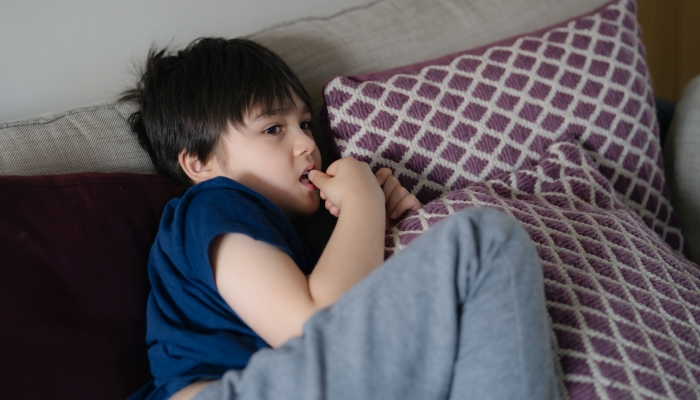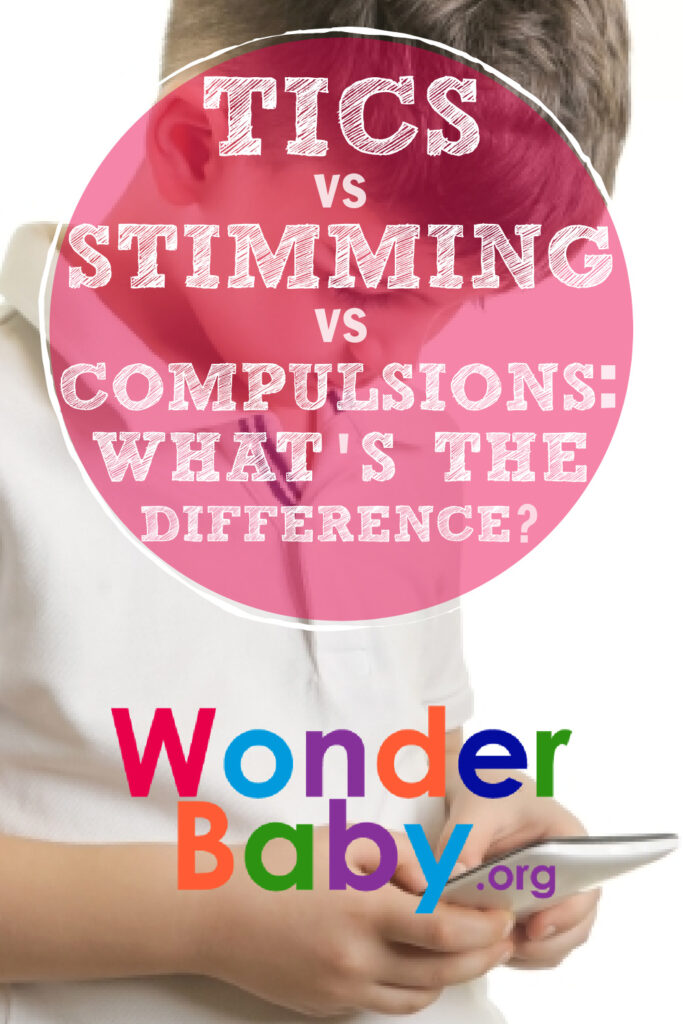Tics vs Stimming vs Compulsions: What’s the Difference?

- Tics, stimming, and compulsions are repetitive behaviors related to anxiety.
- Tics and compulsions present as an overwhelming need to be released.
- Much of the time, stimming can be controlled and is used as a means to self-soothe.
- Mental health professionals can teach parents techniques to manage these behaviors.
- Doctors may prescribe medication at times to control some unwanted repetitive mannerisms.
As a school nurse in an elementary school, I frequently had contact with kids who would stim to self-soothe or were dealing with various forms of tic disorders and compulsive behavior.
I recall one child who could not walk forward into the lunchroom as the floor tile was different than that in the hallway. This change in flooring represented a line that he could not cross if he were striding in a head-on direction.
Instead, this young man needed to repeatedly walk backward into the cafeteria on his way to his lunch table. He could not help his behavior, and by repeating this ritual, he was able to satisfy a driving need inside himself to accomplish his goal.
This boy suffered from obsessive compulsive disorder (OCD), and once his parents had him seek treatment, many of his symptoms diminished.
Compulsive behavior such as the one in this illustration is a mental disorder that is unintentional and completely uncontrollable. This article will help you figure out involuntary behaviors such as tics vs stimming as well as compulsions in children.
After breaking down some basic educational information about these complex disorders, we provide tips on how to manage tics, stimming, and compulsions in children to better help you deal with what can be a perplexing and frustrating issue as a parent.

Identifying Tics
Have you ever known a child or adult who seemed to clear their throat over and over for months on end although they do not appear ill? Just when you think you can not stand the maddening throat clearing any longer, it stops, only to be replaced by constant finger snapping and tapping.
Although this person may just have an annoying habit, there is a good possibility their disturbing habit can’t be controlled. They may be experiencing tics, which are completely involuntary, repetitive behavior that may involve vocal sounds or movement.
Tic disorder may be found in those with tourette syndrome, obsessive compulsive, and autism spectrum disorder. However, there are cases where these repetitive movements and behaviors are not associated with any other conditions.
What Causes Tics?
The cause of tics is very complex and mostly unknown.
Studies show that the “majority of children with tics demonstrated significant emotional sensitivity (70%) and tendency to repress fear and anger (60%)”.
Additional factors that may contribute to tic disorders are due to the following:
- Mild brain changes (shown on MRI)
- Genetic factors
- Stress
- Gestational risk factors
- Learning disabilities
- Underlying epileptic spikes
Those with tourette syndrome and other tic disorders have what is described as a premonitory urge to move or vocalize in a certain way. This feeling to act on this impulse will not go away until the repetitive movement or speech has been released.
Types of Tics
Tics can take on different forms and may change at any time. In fact, a tic disorder is noted for the transient changing of the tic behavior.
Tics are categorized into vocal (phonic) tics and motor (physical) tics. Tic disorders are further differentiated by the complexity of the tic, meaning that the behavior or movement involves more than one muscle group or meaningful sounds (like words or phrases).
Vocal Tics
Simple vocal tics are identified as a single sound repeated frequently.
Examples of simple verbal tics are:
- Grunting
- Sniffing
- Coughing
- Throat clearing
- Barking
- Hissing
- Clicking
A complex vocal tic incorporates actual words or phrases and can be mistaken for purposeful speech, such as:
- Swearing
- Insults
- Repeating what others say
- Calling out inappropriately
Motor Tics
Motor tics are frequent repetitive movements that involve muscle. Once again, these are involuntary movements that may come and go over time.
Physical tics can also be broken down into complex and simple tics.
Simple motor tics may present as:
- Shoulder shrugging
- Facial grimacing
- Head banging
- Neck stretching
- Nose wrinkling
- Lip biting and licking
- Eye blinking
A repetitive movement that involves more than one muscle group is identified as a complex motor tic. Many times this type of repetitive behavior is mistaken for purposeful negative actions.
Complex motor tics may look like:
- Kicking
- Mimicking other’s movements
- Twisting of their body
- Several motor tics happening at once
- Slapping and touching others (or their property)
What Age Do Children Start to Exhibit Tics?
M. Cristina Victorio, MD at Akron Children’s Hospital, indicates that tic disorders “occur in about 20% of children, many of whom are not evaluated or diagnosed. Tourette syndrome, the most severe type, occurs in 3 to 8/1000 children. Male to female ratio is 3:1”.
Children can exhibit different types of tics at once, and repetitive mannerisms can change forms at any time. They typically develop between the ages of 4 and 6 and peak during puberty, only to lessen in the teen years.

Identifying Stimming
The term stimming is commonly associated with autism spectrum disorder. However, most people stim in some fashion. In fact, we may call these behaviors a “habit” (albeit usually considered a bad one).
Examples of stimming can be as commonplace as:
- Hair twirling
- Nail biting
- Neck cracking
- Cracking of knuckles
- Foot jiggling
- Drumming your fingers
Most of us can cease our self-soothing ritual when it is pointed out to us that it is annoying.
However, those in the autistic community employ self-stimulatory behavior that sometimes appears more atypical and, to a certain extent, self-destructive. In this case, these mannerisms are hard to control, and children can not easily stop stimming on command.
Stimming appears in these instances like:
- Hand flapping
- Head banging
- Biting/sucking/rubbing body parts
- Rocking
- Pulling hair
- Hitting own face
- Repeating words or phrases
- Walking around on toes
- Visual stimming such as staring at one object for long periods of time
What Causes Stimming?
The word stimming is based on self-stimulating behavior. Although it is often associated with autism, there are other conditions such as ADHD and some developmental disabilities where stimming is prevalent.
Children stim as a coping mechanism when they experience anxiety or sensory overload. Family members report flapping hands and rocking back and forth repeatedly as the most common self-soothing behavior for their children with autism.

Identifying Compulsions
A compulsion is a strong and unrelenting drive to perform purposeful specific verbal or physical movements. Only after this powerful urge is satisfied through a particular ritual can they carry on with their daily activity.
Many of us have compulsions that are not typically concerning to ourselves and others.
Commonplace compulsions can be as straightforward as:
- Frequently checking our cell phones
- Waking up every hour to check our clock when we have an early wake-up scheduled
- Keeping our house spotless
- Repetitive “Hail Marys” when feeling anxious
Compulsions only become a problem when it interferes with your life and many times are not in your best interest.
A person experiencing a more serious compulsion can not stop themselves from this behavior and feel that they “have” to do the same things over and over to get through the day.
Examples of compulsions that may be regarded as significant are repetitive acts such as:
- Handwashing
- Avoiding cracks in sidewalk
- Counting objects
- Checking and double checking
- Repeating certain words and phrases
Any of these examples can be quite harmless, but when repeated over and over throughout the day causing a child to miss out on school, play, and meals, it is a serious concern.
Obsessive compulsive disorder (OCD) is the primary condition associated with compulsions. However, many other conditions manifest in compulsions that can be equally troublesome, such as:
- Eating Disorders
- Mental compulsions (ex. to harm self or others)
- Hoarding
Compulsions may occur when a person is trying to adapt to a stressful or out-of-control situation. Their adaptation response somehow goes awry, and they learn to deal with their uncomfortable feelings in an unconventional manner – which is their compulsive ritual.
Differences Between Tics, Stimming, and Compulsions
Tics, stimming, and compulsive behaviors may appear to overlap and have many similarities. Although all stem from anxiety, the difference is the reason why children perform these repetitive behaviors.
The table below helps to simplify these disorders.
Difference Between Stimming, Tics, and Compulsions
| Behavior | Purpose/Outcome |
| Stimming | Self-regulatory behavior to de-stress Helps to calm Feels good Mainly involuntary but at times can be controlled |
| Tics | Intense feeling that builds until tic is released Ticcing is the only way to get rid of intense “pre-tic” feeling Does not help to calm anxiety Never voluntary Can suppress for short periods but needs to come out at some point |
| Compulsions | Brings a sense of relief Overwhelming urge to perform before can move on to other activities/thoughts Can put off but may not be able to proceed to another activity |

How to Deal With Tics, Stimming and Compulsions in Children
Having a child who displays confusing and repetitive behaviors such as those diagnosed with autism spectrum disorder, OCD, and tourette syndrome can be quite concerning for parents.
If you have a child who may be dealing with compulsions, tics, or displays stimming behavior, it is best to talk to experts familiar with these issues. Being misinformed on how to manage these habits and mannerisms may only serve to reinforce concerning behaviors.
Once you and your provider and psychologist have developed an action plan, share the findings with those who deal with your child regularly to ensure consistency in response. Include your child’s school, daycare provider, siblings, and other close relatives and friends.
Other tips to help with repetitive behaviors include:
- Provide a calm environment such as a sensory garden.
- Stick to a routine as much as possible.
- Learn effective ways to discipline a child with concerning repetitive habits. Avoid punishing the behavior.
- Stay calm.
- Do not focus on unwanted behavior. Instead, support emotional well-being.
In addition to behavior modification, your provider may prescribe medication to help ease tics and compulsions, such as those found in children with tourette syndrome and OCD.
One Last Word of Advice for Parents
Dealing with a child who displays compulsions, tics, or stimming behavior can be trying and exhausting for parents. Extra energy and patience are needed to tend to a child who needs special attention.
Remember that you need to take care of yourself before you can adequately tend to your daily responsibilities.
Find support through your provider, counselor, Facebook parent groups, and family. Take the initiative to give yourself a break and elicit help when needed (and before you burn out).
Parents of children with special needs are exceptional people. Give yourself credit for all that you have accomplished for your child to this point.

The information WonderBaby provides is not intended to be, and does not constitute, medical or other health advice or diagnosis and should not be used as such. Always consult with a qualified medical professional about your specific circumstances.
Related Posts

Eye Conditions and Syndromes, Visual Impairment
Neuralink Announces Plans to Restore Sight to the Blind with Brain Chip
Elon Musk’s company Neuralink has announced plans to begin human trials of its new “Blindsight” brain chip by the end of 2025.

Special Needs
5 Spring Cleaning Tips for Families of Children with Disabilities
Spring cleaning is an opportunity to create a more accessible, organized, and supportive space for your child with disabilities. Declutter, deep clean, and refresh!

Visual Impairment
The Gift of Understanding: How a Young Child Helps His Blind Father Navigate Life
When a parent is blind, it’s natural for people to wonder how their sighted child will adapt. Will they struggle to understand their parent’s needs? Will they feel burdened by...